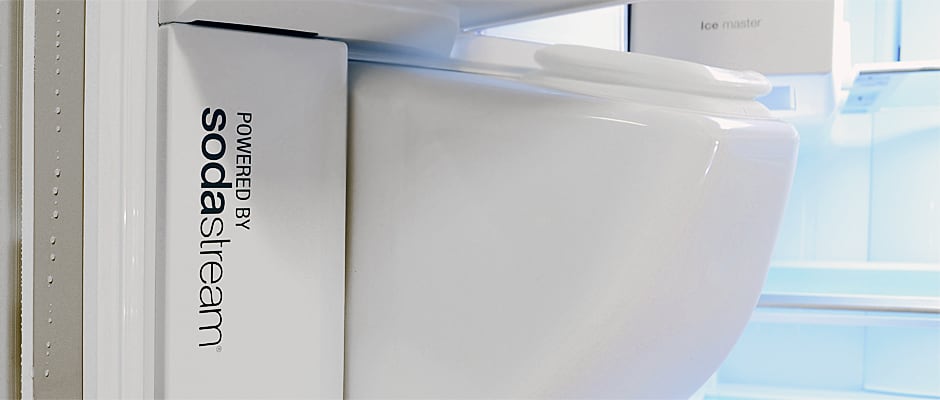Pros
Cons
Introduction
It’s a stylish fridge with fantastic usability, plenty of versatile space, and relatively good energy efficiency to boot. Throw in the sparkling water—an innovation that embraces the SodaStream boom while saving precious counter space–and you’ve got a functionally impressive (albeit expensive) fridge.
Design & Usability
Movable shelves, smooth sliding drawers, and specialty compartments.
One of the latest Samsung fridges, this model continues the company's tradition of blending a white interior with glass shelves and stainless trim. It looks almost identical to the RF4289HARS, except it has a much thinner icemaker. While that change does make for more usable space, it’s an absolute pain in the neck to take out. If you like to host parties or cook outs, be prepared to bang your hand on the fridge door while trying to wrestle the bulk ice tray out of its compartment.
Fortunately, everything else about this fridge screams high-end design. The crispers, as well as the separate temperature control drawer, slide as smoothly as anything else we’ve tested. Speaking of the temp control drawer, it offers detached storage at five separate settings ranging from 42ºF—useful for chilling wine or keeping hors d’oeuvres fresh—all the way down to 29ºF, which is perfect for defrosting meat or storing a freshly bought cut that you’ll be eating later that night.
The right-hand door offers up three large identical and adjustable bins; given the height restrictions, two of those are capable of holding two gallon-sized containers at a time with space left over.
The left-hand door is the least flexible part of the fridge, given the presence of the ice chute. The rest of the fridge, though, is exceptionally versatile. Samsung’s pull-out freezer, while less exciting, has plenty of deep storage sections with enough partitioning to keep your food well organized.
{{inline_gallery "Front", "Fingerprints", "Handles", "Ice Water Dispenser", "Controls", "Ice Water Dispenser Controls", "Interior", "AFridge", "Ice Maker", "Water Filter", "Fridge Door Left", "Soda Stream", "Fridge Door Right", "Flex Drawer", "Flex Zone Controls", "Freezer", "Side", "Back"}}
Performance & Features
Strong performance, a few hiccups... Oh, and sparkling water!
Normally we talk about a fridge's performance first, but we just can't wait to talk about the features on this one. Sure, it's got the standard high-end accoutrements like a power freeze and a slim icemaker, but more importantly, it's the first fridge ever (and hopefully not the last) to come with a Soda Stream hookup and sparkling water reservoir. Choose from three levels of carbonation, give the tank some time to fill, and voila! Homemade seltzer for everything from sparkling lemonade and soda to a refreshing gin fizz. The bubbles, Duke, the bubbles!
Okay, with the really exciting part out of the way, lets talk quality: This fridge does well objectively, but it's not the best you can get for its price. Fresh food storage was quite good, meaning your soft brie and Greek yogurt will do just fine. The freezer, however, was a little more finicky. If you're rotating food in and out fairly frequently, as opposed to buying a giant box of salmon at Costco to preserve for the long term, you should be fine.
But there was enough of a temperature fluctuation over time that anything frozen for too long may begin to develop freezer burn. A freezer this size can hold a few hundred dollars worth of food at a time, but you may not want to stock it with more than you can easily keep track of, otherwise the food you forget about may end up unusable after a long while.
The crispers were fine, but they lost more moisture than we'd expect for such an expensive fridge. They're deep enough that you'll have room to splurge at the farmer's market, though you'll want to limit yourself to what you can eat within a week or less if you want to enjoy prime levels of freshness.

Despite its substantial size, this Samsung was exceptionally efficient. It costs a fair amount to run every year—especially if you're going to take advantage of the icemaker and sparkling water—but the ample storage means all that energy is being used effectively. If the energy cost seems too high, consider that what you pay to the electric company will be significantly less than what it costs to buy a stand-alone Soda Stream.
For in-depth performance information, please visit the Science Page.
The Final Fizz
Tiny bubbles in the fridge make me happy...
Given the popularity of the SodaStream, it’s hard not to fall in love with Samsung's new RF31FMESBSR. Love aside, however, most people don't have the money or the kitchen space to afford this fridge. If you've got the funds and the square footage at your disposal, though, definitely check out this model, especially if you can find some of the outrageously low sale prices that we came across.
Some retailers have slashed prices down to almost $2,500, more than 25% off the $3,899 MSRP. True, it’s not the most perfect fridge we’ve seen when it comes to food preservation, but it’s darn good at caring for food and offers up one of the most useful new features we’ve seen on a fridge in a long time. Now, excuse me while I go refill my glass…
The Cold Hard Facts
Clear away the child-like giddiness caused by the Soda Stream feature, and you're left with an expensive Samsung that, while not the best fridge on the market, is more than up to the task of food preservation. A few stumbling blocks in the freezer, though, may make it hard to justify spending so much if you don't plan to take advantage of the sparkling water.
Temperature Performance
Finicky freezing foils fridge's flawlessness.
Just because a fridge doesn't exactly hit what's displayed on the thermostat doesn't mean it's bad. Such is the case with this Samsung: average temperatures in the fresh food section clocked in at 36.24ºF at the top, 36.38ºF in the middle, and a warmer 40.21ºF at the bottom. On one hand, we'd like to get results that match the calibrated settings, but running three quarters of a degree cooler is fine with us. A bit of extra warmth at the bottom isn't bad, either, since most produce actually should be stored at a slightly warmer temperature than most other refrigerated items. The best part? Average temperature fluctuation throughout was a solid 0.48 degrees; not the best ever, but more than satisfactory.
The freezer, on the other hand, displayed some more prominent consistency issues. Average temperatures at the top were -0.56ºF, with the bottom staying very close at -0.43ºF. That in and of itself is fantastic: our settings had it programmed to stay at 0ºF. Unfortunately, those temperatures shifted over time, continually moving above and below zero. We clocked peak maximum and minimum temperatures at 2.45ºF and -1.07ºF, almost four degrees apart. The constant marginal freezing and thawing is what forms the ice crystals that lead to freezer burn. The balanced temperature spread and relatively small shifts on the bottom should help mitigate this, but you'll want to keep an eye on things regardless.
Moisture Retention
Big drawers with mid-sized performance.
The crispers in the Samsung, despite their smoothness and ample interiors, proved to be only moderately effective at retaining moisture. Our test materials averaged a loss of 0.21 grams of moisture per hour over the course of the testing period. That's roughly on the upper edge of average; a loss any greater than that, and we'd definitely have been disappointed. Produce that needs to retain moisture should stay crisp and fresh for an average amount of time; if you're buying in bulk, many fruits, for which moisture retention is less important, would be better off here.
Freezing & Thawing
Average freezing length with quality insulation.
The freezer on this Samsung is actually a little shorter than average, given the space taken up by having a fully independent adjustable temperature drawer. Even so, it still took a fairly average amount of time to freeze items: our room temperature test materials took one hour and 47 minutes to freeze. This is fairly standard, but even so, a delicate cut of meat like beef tenderloin may undergo a slight reduction in quality when thawed.
Regardless, this freezer sure knows how to retain a chill. After sitting without power for 36 hours, the internal temperature of our test materials had only reached 28.53ºF. Everything was still thoroughly frozen, giving your electric company plenty of time to figure out why you lost power.
Storage Space & Energy Efficiency
Plenty of space, and exceptionally efficient.
Design features like the slim icemaker in the fridge work to optimize storage, but the separate drawer in the middle inevitably cuts in on some of the overall storage. (That extra insulation has to go somewhere, after all.) Nevertheless, the five assorted shelves in the fridge, in addition to the ample crispers, provide a healthy amount of space that should suit even larger families. The three shelves on the right-hand door can fit more than two gallon-sized containers each, plus you've got three smaller shelves on the left-hand door for small item storage. We considered the temperature controlled drawer as fridge space for the purposes of our scoring, since many other models keep their own temp drawer inside the fridge compartment. As such, it all adds up to a fairly impressive 10.97 cubic feet of usable space.
{{inline_gallery "Fridge Storage", "Fridge Door Left Storage", "Fridge Door Right Storage"}}
The freezer is much more straightforward: you've got a wide pull-out drawer on top, and a deep bucket on the bottom bisected by a plastic divider. There's also a shallow shelf just on the inside of the freezer door for storing smaller items like popsicles, ice packs, or bags of chocolate chips. These all combine to create 7.54 cubic feet of usable storage—not a ton, but more than enough for many consumers.
In terms of energy consumption, this particular Samsung is a rather unusual beast. On one hand, our data indicates that it would cost you $74.55 per year to operate based on a rate of $0.09 per kWh—undeniably expensive. Even so, the amount of storage available means you're only pulling 0.12 kWh per usable cubic foot of space—undeniably efficient. A lot of the energy demand comes from the icemaker and sparkling water reservoir, two things which—unless you're getting ice or sparkling water on a frequent and regular basis—aren't running constantly. That's something to keep in mind, especially given the already very low ratio of power to cubic foot of usable space.
Meet the tester
Matthew is a native of Brockton, MA and a graduate of Northeastern, where he earned a degree in English and Theatre. He has also studied at the Gaiety School of Acting in Dublin and spends most of his free time pursuing a performance career in the greater Boston area.
Checking our work.
Our team is here to help you buy the best stuff and love what you own. Our writers, editors, and experts obsess over the products we cover to make sure you're confident and satisfied. Have a different opinion about something we recommend? Email us and we'll compare notes.
Shoot us an email

